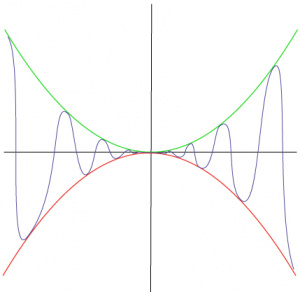Difference between revisions of "Squeeze Theorem"
m |
(There's no need for the inequalities to be strict) |
||
| Line 8: | Line 8: | ||
==Proof== | ==Proof== | ||
| − | If <math>f(x)</math> is between <math>g(x)</math> and <math>h(x)</math> for all <math>x</math> in the neighborhood of <math>S</math>, then either <math>g(x) | + | If <math>f(x)</math> is between <math>g(x)</math> and <math>h(x)</math> for all <math>x</math> in the neighborhood of <math>S</math>, then either <math>g(x)\leq f(x) \leq h(x)</math> or <math>h(x)\leq f(x)\leq g(x)</math> for all <math>x</math> in the neighborhood of <math>S</math>. Since the second case is basically the first case, we just need to prove the first case. |
If <math>g(x)</math> increases to <math>L</math>, then <math>f(x)</math> goes to either <math>L</math> or <math>M</math>, where <math>M>L</math>. If <math>h(x)</math> decreases to <math>L</math>, then <math>f(x)</math> goes to either <math>L</math> or <math>N</math>, where <math>N<L</math>. Since <math>f(x)</math> can't go to <math>M</math> or <math>N</math>, then <math>f(x)</math> must go to <math>L</math>. Therefore, <math>\lim_{x\to S}f(x)=L</math>. | If <math>g(x)</math> increases to <math>L</math>, then <math>f(x)</math> goes to either <math>L</math> or <math>M</math>, where <math>M>L</math>. If <math>h(x)</math> decreases to <math>L</math>, then <math>f(x)</math> goes to either <math>L</math> or <math>N</math>, where <math>N<L</math>. Since <math>f(x)</math> can't go to <math>M</math> or <math>N</math>, then <math>f(x)</math> must go to <math>L</math>. Therefore, <math>\lim_{x\to S}f(x)=L</math>. | ||
Revision as of 20:40, 4 May 2008
| This is an AoPSWiki Word of the Week for May 4-11 |
The Squeeze Theorem (also called the Sandwich Theorem or the Squeeze Play Theorem) is a relatively simple theorem that deals with calculus, specifically limits.
Theorem
Suppose ![]() is between
is between ![]() and
and ![]() for all
for all ![]() in the neighborhood of
in the neighborhood of ![]() . If
. If ![]() and
and ![]() approach some common limit L as
approach some common limit L as ![]() approaches
approaches ![]() , then
, then ![]() .
.
Proof
If ![]() is between
is between ![]() and
and ![]() for all
for all ![]() in the neighborhood of
in the neighborhood of ![]() , then either
, then either ![]() or
or ![]() for all
for all ![]() in the neighborhood of
in the neighborhood of ![]() . Since the second case is basically the first case, we just need to prove the first case.
. Since the second case is basically the first case, we just need to prove the first case.
If ![]() increases to
increases to ![]() , then
, then ![]() goes to either
goes to either ![]() or
or ![]() , where
, where ![]() . If
. If ![]() decreases to
decreases to ![]() , then
, then ![]() goes to either
goes to either ![]() or
or ![]() , where
, where ![]() . Since
. Since ![]() can't go to
can't go to ![]() or
or ![]() , then
, then ![]() must go to
must go to ![]() . Therefore,
. Therefore, ![]() .
.










